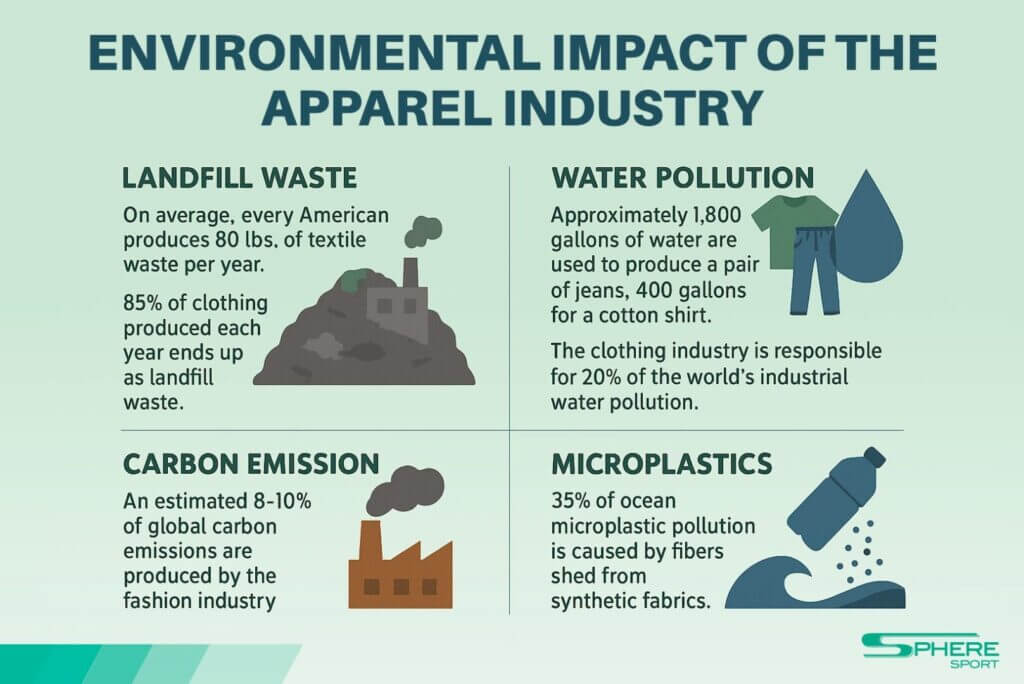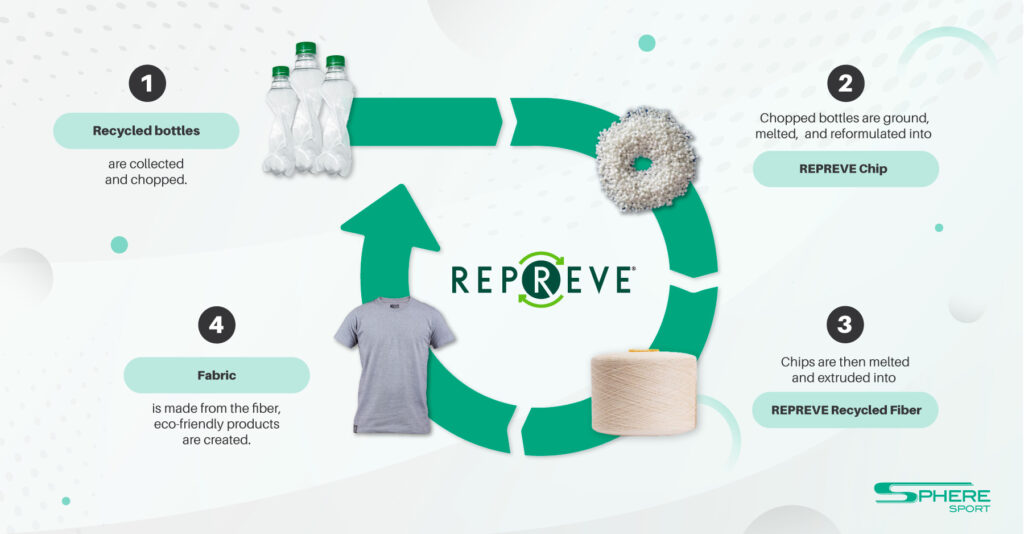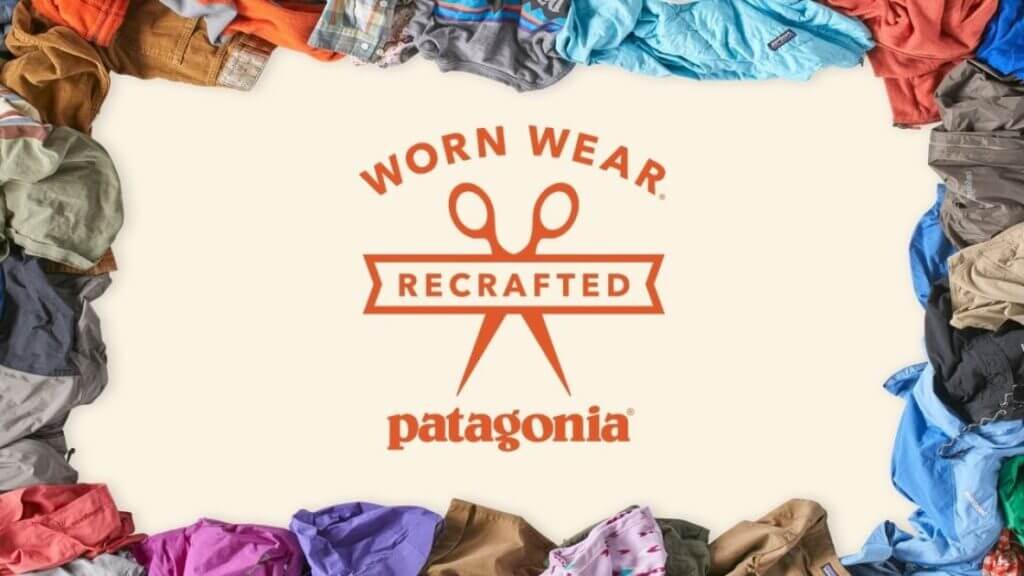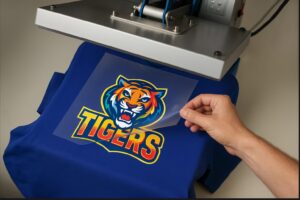Introduction
If you’re a brand owner, you’re likely aware of the growing pressure to adopt sustainable practices. Consumers are becoming more eco-conscious, and the apparel industry is under intense scrutiny for its role in environmental harm, increasing the need to become a sustainable apparel brand.
You’re not alone in facing these challenges, but there’s an opportunity for you to lead the change. In this guide, we’ll walk you through a practical, step-by-step approach to building a more sustainable brand—helping you meet consumer expectations, reduce risks, and improve your long-term brand value.
Step 1: Understand the Problem
Before embarking on a journey toward sustainability, it’s critical to first understand the complexities and challenges that plague the apparel industry in terms of environmental impact.
A comprehensive grasp of the problem will not only inform your sustainability strategy but also allow you to set tangible goals that make a real difference.
Excessive Water Consumption
Textile production uses about 79 trillion liters of water every year. That’s not just a statistic, it’s a real strain on local communities, ecosystems, and the future of your supply chain. Cotton farming, dyeing, and finishing all require huge amounts of water, often in regions already facing scarcity.
High Carbon Emissions
The fashion industry is responsible for up to 8% of global carbon emissions. Every step—raw materials, manufacturing, shipping, retail adds up. If your brand relies on polyester or runs on a long, fossil fuel-driven supply chain, you’re likely contributing more than you think to climate change.
Textile Waste and Pollution
In the U.S. alone, more than 85% of clothing ends up in landfills or incinerators each year. Fast fashion has fueled a disposable culture, and even if you’re not in that space, your products may still be part of the cycle. On top of that, synthetic fabrics release microplastics into waterways every time they’re washed, harming marine life and polluting ecosystems.

Step 2: Make “Green” Changes
As you venture into transforming your business to a sustainable apparel brand, simply understanding the environmental challenges is not enough; actionable steps must follow. This section serves as a pragmatic guide to turn your newfound knowledge into tangible actions.
Here, we’ll focus on strategies for implementing eco-friendly practices across various facets of your business, from sourcing and manufacturing to packaging and consumer engagement. This is where your sustainable apparel brand begins to make a quantifiable difference, setting the stage for long-term sustainability.
Set Tangible Sustainability Goals
Start by establishing measurable and realistic sustainability goals. Then, utilize tracking tools and periodic sustainability audits to assess your progress against these established metrics. Such precision not only gives your team clear objectives but also provides a basis for evaluating the effectiveness of your sustainability initiatives.
Here are some practical examples:
- Carbon Footprint Deduction: Aim to reduce your carbon footprint by a specific percentage say, 20% within the next 12 months. Use carbon accounting software to measure progress.
- Waste Diversion: Strive for a waste diversion rate of at least 90% from landfills within a year, focusing on recycling, reusing, or composting waste materials.
- Water Usage: Target a water reduction goal, perhaps aiming to decrease water consumption in your manufacturing processes by 15% within a fixed period.
Conduct a Sustainability Audit
A sustainability audit is a systematic review that assesses how well a company adheres to ethical and environmental guidelines. It helps organizations evaluate their current sustainability performance and identify areas for improvement.
Benefits of a Sustainability Audit
Auditing your operations is essential for establishing a baseline as a sustainable apparel brand. You could conduct this audit internally, but third-party audits are usually more objective and comprehensive. Specialists can evaluate your current supply chain, manufacturing process, packaging, and more.
How to Conduct a Sustainability Audit
To implement a sustainability audit, start by selecting a reputable third-party auditing firm specializing in the apparel industry. Schedule an audit that encompasses your entire supply chain, from raw material sourcing to manufacturing and packaging, and prepare relevant documents and data for a thorough evaluation.
Check our guide on how to conduct a sustainability audit to learn more.
Source Sustainable Materials
Sustainable sourcing refers to the procurement of raw materials in a way that both minimizes environmental impact and ensures ethical practices throughout the supply chain.
This involves selecting materials that are renewable, certified organic, or recycled, while also considering the labor and environmental practices of suppliers.

Choose Organic and Renewable Fabrics
Switching to sustainable materials like organic cotton, Tencel, and REPREVE fabric can drastically reduce your apparel brand’s environmental footprint. These materials consume fewer resources, reduce chemical pollution, and are often biodegradable.
Build Ethical Supplier Relationships
Work with suppliers who align with your sustainability vision. Conduct regular audits and require transparency in their environmental and labor practices to ensure they meet ethical sourcing standards.
Adopt Ethical Manufacturing Practices
Ethical manufacturing encompasses the fair labor practices and safe working conditions under which products are made. It ensures that workers are treated respectfully and paid fairly, while also minimizing the manufacturing process’s environmental impact.
Work with Certified Manufacturers
Work only with factories and manufacturers that follow good labor practices. Ethical certifications such as Fair Trade, B Corp, BSCI and GOTS (Global Organic Textile Standard) can serve as reliable benchmarks.
At Sphere Sport, we value work-life balance and prioritize efficiency during business hours, minimizing overtime. We’re committed to ethical practices and proudly adhere to BSCI standards.—view our latest audit report.
Conduct On-Site Factory Visits
If possible, visit these manufacturing plants yourself. Nothing beats firsthand experience when it comes to verifying ethical and sustainable practices.
Use Eco-Friendly Packaging
Eco-friendly packaging focuses on using materials and design approaches that minimize environmental impact and waste. This involves opting for recyclable, biodegradable, or compostable packaging materials and reducing unnecessary packaging elements.
Choose Sustainable Packaging Materials
Your packaging is often the first tangible interaction that a customer has with your brand. Make it count by choosing eco-friendly packaging options like recycled cardboard, compostable bags, or reusable fabric pouches.
Educate Customers Through Packaging
Be transparent about your eco-friendly packaging by providing details on the material used, the life cycle of the package, and how it can be recycled or reused.
Choose Carbon-Neutral Logistics
Sustainability isn’t just about what you make, it’s also about how you get your products into your customers’ hands. Shipping is often an overlooked part of your brand’s footprint, but it’s a key area where you can reduce emissions and show your commitment to doing better.
Partner with Carbon-Neutral Logistics Providers
Start by choosing carriers that are already doing the work to offset their emissions. Companies like DHL GoGreen, UPS Carbon Neutral, and FedEx EarthSmart invest in environmental projects, from reforestation to renewable energy to balance out the impact of their deliveries. Partnering with them helps lower your supply chain emissions without adding major complexity to your operations.
Implement Emission-Reducing Delivery Strategies
Consolidate orders when possible, switch to eco-friendly packaging, and offer slower, greener shipping options at checkout. Encouraging your customers to choose fewer, bundled deliveries instead of multiple smaller shipments can also make a noticeable impact without compromising their experience.
Step 3: Implement a Recycling Program
Once you’ve laid the groundwork for sustainability through thoughtful sourcing, ethical manufacturing, and eco-friendly packaging, the next logical step is by facilitating the recycling or repurposing of your products.
Many leading apparel brands, such as Patagonia’s Worn Wear, Levi’s SecondHand, and H&M’s Garment Collecting Program, have successfully integrated take-back and recycling initiatives, offering both environmental and business benefits.

Launch a Take-Back Scheme
Offer a system where customers can return old items from your brand for recycling or repurposing. This not only promotes responsible consumption but also provides you with materials that can potentially be reused.
To implement a take-back scheme for your sustainable apparel brand, consider the following practical steps:
- Publicize the Program: Use your website, social media, and email newsletters to educate customers and raise awareness.
- Set Up Collection Points & Logistics: Establish drop-off locations in stores or partner with local collection centers. Work out logistics for sorting, transporting, and processing the returned items.
- Offer Incentives: Provide discounts, loyalty points, or store credit to encourage participation.
- Ensure Compliance & Track Performance: Align with local recycling regulations and monitor participation rates to refine your program over time.
Introduce Loyalty Program
Combine sustainability with customer retention. Offer loyalty points or discounts on future purchases when customers participate in your recycling program.
To create a successful loyalty program for your sustainable apparel brand, you might consider the following practical steps:
- Points & Tiered Rewards System: Give customers points for each purchase, and tiered rewards to encourage higher spending and offer discounts or gifts.
- Personalize the Experience: Use customer data to tailor incentives, such as birthday discounts or rewards for frequent participation.
- Ensure Multi-Channel Access: Allow customers to track and redeem rewards through in-store, mobile app, and online platforms.
- Monitor & Optimize: Use analytics tools to track engagement, customer retention rates and ROI to make data-driven improvements.
Key Takeaways:
- Implement a take-back scheme to extend product life cycles and minimize waste..
- Integrate sustainability into your loyalty program to build long-term engagement.
Step 4: Educate Your Customers
While recycling programs extend product life, true impact comes when customers join your mission. Educating your audience is a powerful way to expand your sustainability efforts beyond the production line.
Leverage Content Marketing
Utilize the power of content marketing to educate your audience about sustainable fashion. Blog posts, social media updates, and YouTube videos can all serve as platforms to share valuable insights and updates about your journey to being a sustainable apparel brand.
- Add a short story or sustainability fact on your product pages or packaging, explaining how each product is made.
- Share behind-the-scenes photos, simple eco-tips, or product care tips regularly on Instagram in email newsletters, like Tentree does.

Share Customer Testimonials
Showcase testimonials from satisfied customers who appreciate your eco-friendly practices. Real-world validation can encourage others to become conscious consumers. Encourage customers to detail how your sustainable products have positively impacted their lives, emphasizing quality, durability, or environmental benefits.
- When customers leave positive reviews or share product photos, ask permission to repost them on social media with a focus on their sustainable habits.
- Feature one customer story in your email newsletter each month, showing how they care for or extend the life of your product.
Collaborate with Sustainability Experts
Partner with sustainability advocates, fashion researchers, or environmental organizations to add credibility and depth to your message. You can host webinars, co-create content, or invite guest contributors to share expert insights on sustainable practices and conscious consumerism.
- Invite a sustainability advocate or local expert to write a short blog post or share a tip on your social media.
- Collaborate with an environmental organization to create an easy-to-read guide or checklist for customers on how to care for their clothes sustainably.
Key Takeaways:
- Leverage content marketing to inform and engage.
- Use customer testimonials to validate your sustainability efforts.
- Partner with experts to share deeper insights and build your authority.
Step 5: Monitor, Adjust, Repeat
After establishing your sustainability initiatives, continuous oversight is imperative for lasting impact. This is where your sustainable apparel brand journey transforms into a cycle of perpetual improvement.
Regular Reporting
Create a sustainable dashboard where you can monitor Key Performance Indicators (KPIs) related to your sustainability goals. Regular reporting will help you stay on track and make data-driven decisions. For example:
- Carbon emissions per product
- Water usage during production
- Percentage of recycled or responsibly sourced materials
Tools like the Higg Index or Ecochain make it easier to gather and interpret this data. These numbers will show you what’s working, what’s not, and where to focus next.
Be Transparent With Your Progress
Sharing your sustainability progress openly helps build trust with your customers. When you communicate both your achievements and the areas where you’re still working to improve, your audience will see your commitment as genuine.
- Create a dedicated page or section on your website where you regularly share updates on your sustainability goals and progress.
- Include simple progress updates in your email newsletters or social media posts to keep customers informed and involved.
Be Ready for Change
Sustainability is a moving target. As technologies and methods improve, be ready to adjust your strategies accordingly.
- Review your materials, packaging, and production processes regularly to identify areas where you can reduce waste or improve efficiency.
- Ask your customers and team for feedback on how you can improve your sustainability efforts and make small, continuous changes based on that input.
Key Takeaways:
- Track your impact with clear, relevant KPIs
- Share your progress transparently with stakeholders and customers
- Regularly revisit and improve your strategy to stay aligned with evolving best practices
Conclusion
Transitioning your business into a sustainable apparel brand is an ongoing journey, not a one-time switch. Ultimately, it’s a commitment that not only positions your brand as a responsible business but also resonates deeply with today’s consumer.
If you’re serious about elevating your apparel brand’s sustainability, there’s no better supplier than Sphere Sport. As a B2B sportswear manufacturer, we offer a range of eco-friendly fabrics like REPREVE, innovative packaging options, and have consistently high scores on our BSCI audits.
Located in Dongguan, China, we’re at the forefront of integrating sustainability into the sports apparel space. Don’t just take our word for it—experience the Sphere Sport difference yourself and make your brand synonymous with sustainability.
Contact us today to learn more or to request a sample of our sustainable fabrics. Let’s create a future where sustainability and sportswear go hand in hand.






